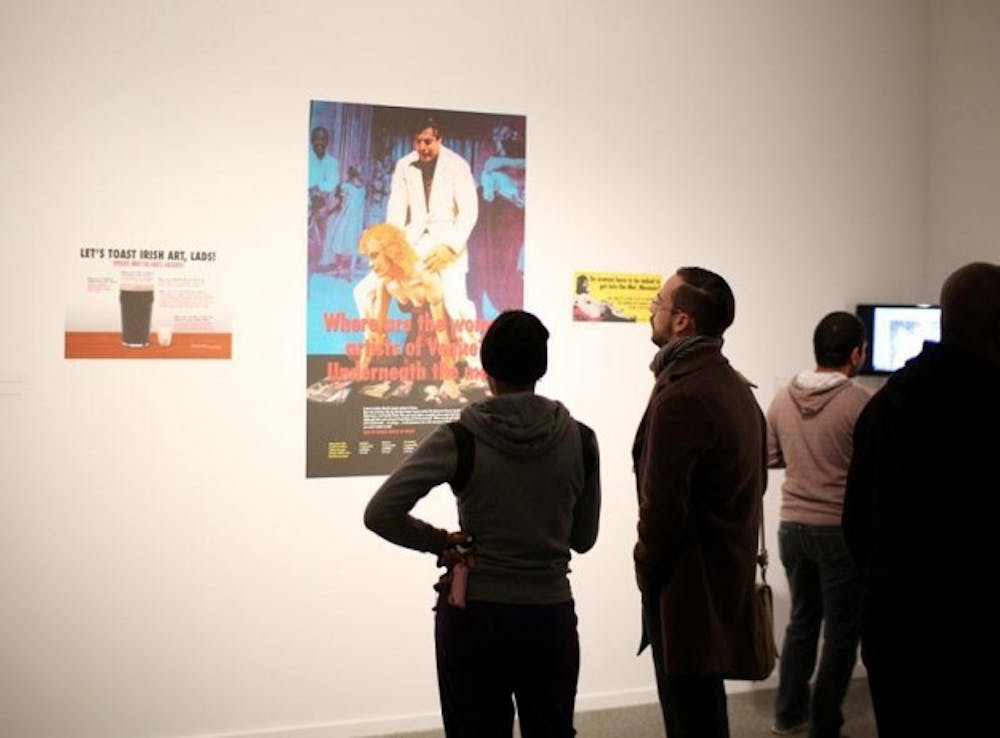Regina Jose Galindo stands naked in an open field. A stationary camera watches the artist as an excavator loudly strips the grass and dirt from the earth's skin around her. In the chaos of the destruction, she stands erect - unmoved and unaffected. If the viewer watches long enough, Galindo is left on a tiny island of dirt slowly crumbling beneath her feet.
This curious video is one of 15 works featured in Fight Club: Politics, Law and Art, an exhibition currently on display in the Center For the Arts' Lower Visual Studies Gallery.
The exhibition opened Nov. 7 and displays original work from 15 different artists interested in exploring ideas of politics and law and their relationship to art in contemporary culture and society. The title of the exhibition is partially inspired by the famous film and novel Fight Club, but the real ideas driving the overall body of work are the brainchild of Mark Snyder, a 50-year-old Buffalo native currently working on completing his Master's of Fine Arts at UB.
Snyder described Galindo's piece, Tierra, as a reflection on the former state of the Guatemalan government dictated under Jose Rios Montt.
"It emphasizes the vulnerability, it shows the mechanism of the government and just the inhumanity in many ways," Snyder said. "Each artist in this exhibition produces works that expose invisible power structures and hierarchies, marking them for the public to see and confront."
Snyder began working on organizing Fight Club at the end of the summer, carefully selecting the artists who met the specific criteria he set forth for the exhibition.
Natalie Fleming, 25 of Carmel, N.Y., has been working alongside Snyder to get Fight Club up and running. She hopes the work will allow individuals to walk away with a better understanding of two things: the variety of forms that art can take and the variety of ways artists can engage in the important social/political issues of today.
Most of the pieces are interactive, which allows for direct engagement between the artists' work and the audience.
Jennifer Gradecki, a visual studies Ph.D. student, has a piece featured in the exhibition that is modeled after a psychological study in which participants had the opportunity to shock other participants.
In Gradecki's interactive piece, viewers can actually give someone else a shock to experience the experiment.
One painting, similar to a Verizon coverage map, took up an entire wall in the gallery from floor to ceiling.
Territories is the work of Patrick Foran, 34, andrepresents American Indian reservations in the United States. The Lansing, Mich. native created the map in three days. He is not an American Indian himself.
"In part, I made this work to educate myself on the history of land struggles and sovereignty issues for Native Americans," Foran said. "But I think it's also about the blind spot these territories occupy in the mind of most non-indigenous people, including myself."
Aside from his own work, Foran was impressed with the depth and diversity Snyder compiled for the show. He felt it has inspired conversation with his program and within the community.
Jeff Sherven, 50, a print media technician and instructor at UB, was also a contributor for Snyder's exhibition.
Sherven admires the collected works for the variety they present to the audience.
"The nice thing to have a show like this is that [the artists] each have particular qualities, tactile qualities, sensory qualities, in terms of sound or even auditory pieces," Sherven said. "All of a sudden you get connected with historical data in terms of slavery or the issues related to Jim Crow, then you turn around and deal with how sex is a real arbiter of who we are."
He explained that the artists have found a way to express a variety of topics in a subtle way, so the issue isn't always obvious at first.
"Every one of the artists here have found a way to re-contextualize what is contemporary data and awareness," Sherven said.
Fight Club: Politics, Law and Art will be on display at the Lower Visual Studies Gallery until Jan. 25.
email: arts@ubspectrum.com





